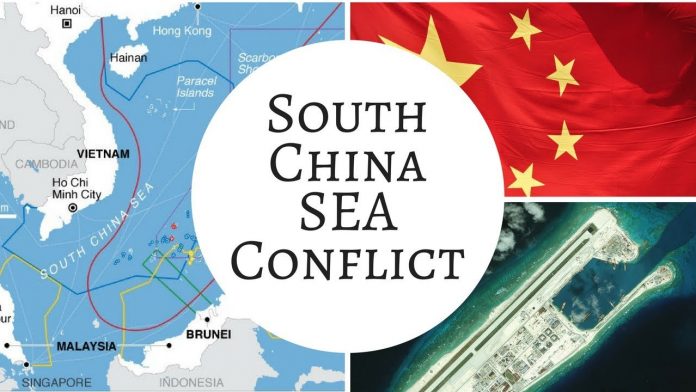This article is written by R Sai Gayatri from Post Graduate College of Law, Osmania University. This article deals with the South China Sea conflict and its effect on India.
Table of Contents
Introduction
The South China Sea (SCS) conflict is a multinational dispute going on between China, Taiwan, the Philippines, Brunei, Malaysia, and Vietnam. The South China Sea is the most important water body for the said countries as it is the only waterway that provides them with merchant shipping and trade. These countries are all situated in the Indo-Pacific region which is one of the principal reasons for the dispute as they all claim maritime and island ownership over the South China Sea. Through this article, let us know more about the South China Sea conflict and how India is connected to it.
A brief history of the South China Sea conflict
Some of the islands in the South China Sea were under the colonial authority of the French. However, during World War II, the Imperial Japanese Army and Navy made use of various islands for military purposes and mentioned that the said islands were not claimed by any country. The Treaty of San Francisco in 1951 put an end to the control of Japan on all such territories which were conquered by it during the said war. At the same time, China got involved in this matter during the said Treaty’s negotiations in 1951 and claimed rights over the concerned islands.
China never shied away from claiming the islands. It all started in 1947 with the eleven-dash line demarcated by the Kuomintang government of China. Later in 1949 when the People’s Republic of China was formed the eleven-dash line was renamed and adopted as the nine-dash line. The Declaration of 1958 mentioned the claims of China upon the South China Sea islands as per the nine-dash line. The military and government officials of the People’s Republic of China provided a historical basis to their claim over the South China Sea through the nine-dash line.
The main islands i.e the Paracels and Spratlys were to be considered as a part of Vietnamese territory as per the Geneva Accords of 1954. The said Accords marked the end of the first Indo-China war and provided South Vietnam with the authority over those Vietnamese territories that were to the south of the 17th Parallel. However, in 1956, it was stated by North Vietnam that the islands must be claimed by China and not South Vietnam.
Countries concerning the South China Sea conflict
The following countries have made various claims over different parts of the South China Sea –
China
As already mentioned above, China claims its ownership over the South China Sea based on the nine-dash line and other ancient historical records. The country states that it had the sole authority over the whole of the South China Sea and the conflicts began with other countries lately. China also tried to state its legal rights over the South China Sea, however, all its attempts proved to be futile as it could not establish its claims.
Philippines
Just like China, even the Philippines claims its rights over the South China Sea based on historical records. However, they do not claim rights over the whole waterway but just that area that falls under their Exclusive Economic Zone.
Brunei
This country claims its rights over the South China Sea on the grounds of the Exclusive Economic Zone. The concept of the Exclusive Economic Zone was established by the United Nations Convention on the Law of the Sea (UNCLOS).
Indonesia
Located just beside Brunei, Indonesia also has claimed its rights over the South China Sea based on the concept of the Exclusive Economic Zone. It claims only that part of the Sea that falls under Indonesia’s EEZ.
Malaysia
This country approaches the South China Sea conflict exclusively on legal grounds. It states that the southern part of the Spratly Islands is located inside the Malaysian continent and so its claim over the said part of the South China Sea must be legally acceptable.
Vietnam
The strained relations between Vietnam and China led to Vietnam claiming its rights over the South China Sea in the 1970s. The claims made by this country are based on the grounds of inheritance.
Causes of the South China Sea conflict
The following are the causes for the South China Sea conflict affecting the relations between China and the Association of Southeast Asian Nations (ASEAN) –
Exclusive Economic Zones (EEZ)
The South China Sea conflict is also fuelled by the exclusive economic zones. Most of the countries involved in the conflict based their claims on the grounds of an exclusive economic zone. This means that they are claiming their rights over the South China Sea only to the extent of their exclusive economic zone and not beyond that.
Natural resources
The South China Sea is said to be rich in crude oil and natural gas. If the whole control of the said Sea is under a single country then it would definitely dominate over the other countries in matters of trade and export. Therefore, the countries involved in the dispute are specifically concerned about the extraction of these natural resources as well.
Claims over the South China sea
All the nations surrounding the South China Sea are claiming rights over various parts of it. These nations include China, Taiwan, the Philippines, Brunei, Indonesia, Malaysia, and Vietnam. While one country claims its rights based on history the other claims its rights based on the concept of the economic zone. The demarcation of the South China Sea as per the territories is also one of the main reasons for the conflict.
Islands
The islands of the South China Sea have been claimed by the countries involved in the dispute. This leads to further conflicts in the trade as the waterway passes through these islands where the ships might be seized.
Fishery
The South China Sea forms a major part of the fishery of various countries involved in the conflict. Seafood is considered the staple food of the southeast Asian countries and the South China Sea is an essential source for acquiring such seafood. Thus, the countries concerning the conflict consider it a threat to let one nation have control over the South China Sea.
Effects of the South China Sea conflict
The South China Sea conflict has varied effects on both – the countries involved in the conflict and the other countries that have trade links with them. The South China Sea route plays a key role in international trade, so any hindrance in it would affect the economy of the countries directly or indirectly related to it. The said conflict must be settled amicably so that there will exist harmony among the nations and smooth running of international trade.
India and the South China Sea conflict
In 2014, India and the United States of America pronounced a joint statement under the ‘Act East’ policy. It was stated by both nations that a resolution pertaining to the territorial and maritime disputes must be pursued through peaceful means adhering to the globally recognized standards of international law which include the United Nations Convention on the Law of the Sea. Further, the statement also threw light upon protecting maritime security and facilitating freedom of navigation and overflight over the region of the South China Sea.
The South China Sea route plays a significant role in maintaining India’s trade links with other nations. In order to trade with the countries situated in the southeast Asian region, India has to have a proper trade channel and in this case, the channel is the South China Sea. Therefore, India tries its best to not intervene in the internal disputes among the sovereign states.
The South China Sea witnesses a very high rate of international trade passing through the Malacca Strait, which is a significant part of the South China Sea. The South China Sea constitutes one-third of the total global shipping. Over 55 percent of India’s trade passes through the South China Sea that includes the Malacca Strait. In case, a single country takes control over the whole of the South China Sea then it will be the dominating country having the sole authority over the waterway which could affect Indian trade drastically and might lead to major economic issues. To avoid similar situations, India holds a stake in ensuring the freedom of passage in the said area.
Even though India is not a party to the South China Sea conflict, it is forced to get involved in it due to reasons such as – strengthening relations with the ASEAN countries, safeguarding the Indian Ocean region against China, improving maritime security, and fulfilling its Act East Policy.
Resolution of the South China Sea conflict
In the present world, where trade is such an important aspect of the economy both globally and domestically for all the countries it is better for them to have amicable relations with each other. Continuing the South China Sea conflict would only result in economic issues and strained relations among the countries involved. So the parties to the conflict should take wise decisions to reach an understanding and resolve the conflict as soon as possible through diplomacy. It is normal that there will be some form of resistance shown by people towards the decisions taken by the governments of their respective nations but we should always consider the benefit of all over the greed of few. Hence, it is important to solve the disputes among the nations in a diplomatic yet effective manner.
Methods to resolve the South China Sea conflict
The country claiming its rights over the South China Sea region must be ready to forgo the competitiveness of owning a part of the sea and rather draw an agreement by finding a middle ground in its claims which conflict with other countries.
All the nations involved in the conflict may, if not forgo, at least limit their claim over the South China Sea to an area of two-hundred nautical miles of the Special Economic Zone (SEZ) as mentioned in the United Nations Convention on the Law of the Sea (UNCLOS). This will result in equal hold of all the claimant nations over the South China Sea. Further, the international waterway would be open for free passage of trade. Alternatively, joint ownership can be established among the nations for those areas of the South China Sea that are subject to conflict. This would help in the equal distribution of wealth acquired among the claimant nations.
Alternatively, a neutral nation that is indifferent to the gains/loss caused by the conflict must be given the responsibility to carefully study the claims of each nation claiming its rights over the South China Sea and produce a resolution that adheres to the principles of the United Nations Convention on the Law of the Sea (UNCLOS) or any other international law. A resolution through the means of bilateral negotiation was suggested by China, however, it has been rejected by other claimant countries based on the assumption that China being a huge nation will automatically be at an advantage over the others in claiming portions of the South China Sea.
Conclusion
The South China Sea is one of the most significant trade routes in the world. China claims its rights over the whole of the South China Sea based on historical records and the nine-dash line laid down by it in the past. While most of the other claimant nations claim their rights over the said Sea based on the concept of Exclusive Economic Zones. The countries involved in claiming their rights over the said Sea must solve the conflict among themselves as they are not only affecting the international trade but also the economy of the countries involved with them. India wants to stay away from the internal disputes of the sovereign states but it is compelled to get involved in it due to its trade link with the nations in the Southeast Asian region. However, the resolution to the conflict must be sought in such a way that it does not strain the relations between the claimant nations.
References
Students of Lawsikho courses regularly produce writing assignments and work on practical exercises as a part of their coursework and develop themselves in real-life practical skills.
LawSikho has created a telegram group for exchanging legal knowledge, referrals, and various opportunities. You can click on this link and join:
 Serato DJ Crack 2025Serato DJ PRO Crack
Serato DJ Crack 2025Serato DJ PRO Crack









 Allow notifications
Allow notifications



